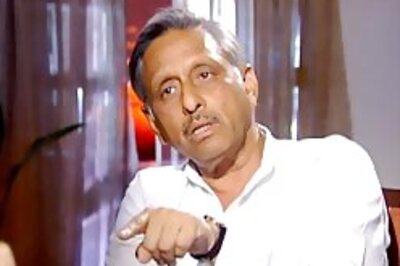
views
No more jingoistic advertising, no more sms polls predicting an India triumph, no employee flexitime to watch the late light matches, no sepia-tinted flashback to 1983, no musical tributes to the team, no yagnas being performed to pray for an Indian triumph, and yes, no non-stop television programming. India could get back to real work.
Watching a visibly shaken Rahul Dravid and Greg Chappell after the game, one was saddened at the sight of two proud men and outstanding cricketers being mercilessly grilled by the media. Two fallen matadors trapped in a bullring, this was the flip side of the fame game. Atleast, Dravid and Chappell are alive to tell the tale. Only 24 hours earlier, the world had been told that Pakistan coach Bob Woolmer had been killed, strangulated within a day of Pakistan losing to lowly Ireland and being bundled out of the tournament.
Unfortunately, in an era of instantaneous television, news often has an hourly shelf life: only the here and now matters. Woolmer may have died, Inzamam may have retired. That was the past. Today,it was the turn of Dravid and Chappell to be crucified. What price the life and dignity of an individual when the "pride" of a nation is at stake?
Unfortunately, cricket nationalism is often no longer a spontaneous expression of support for ones team, but simply jingoism that has spiraled out of control. Just look at the "fan" reaction to the Indian team's exit from the World Cup. Those same smiling faces painted in tricolor who we had watched across every television screen for days were now carnivorous beasts, maddened by the thought that their heroes had let them down. Joyous cheering had now given way to abusive rants. From lining up on the streets of Ranchi to catch just one glimpse of MS Dhoni's sweeping locks, a blood-thirsty mob was now burning his effigy. In the land where Sachin Tendulkar is a deity, he was now being dismissed as the god that failed.
The lumpenisation of the cricket fan is not a new phenomenon. Over the years, several sub-continental teams have had to face the wrath of the street. From Ajit Wadekar in 1974 to Wasim Akram in 1996 to Rahul Dravid in 2007, the sub-continent spectator's love-hate relationship with his cricketing idols has seen periodic bouts of public anger spill out onto the road. The difference in recent years is that the manic behaviour of the so-called fan has been magnified by round the clock media coverage of the game.
The 'carpet-bombing' of cricket has meant that the men in blue are now the country's most recognizable faces, staring at you from every nook and corner of the land. One moment they are brand names selling you a cola, the very next they are warriors expected to vanquish all their rivals.
As a result, watching cricket is now a bit like creating the ultimate escapist adventure, where the players are expected to be superheroes who must either perform or perish on a daily basis. The so-called cricket "enthusiasm" is really little more than voyeurism in disguise, the affection is not for the traditions of the game, but for a certain mindless clamour for glamour and titillation. In this "page threeisation" of cricket, you can be a "star" one day, a "mujrim" the very next, the transition from hero to villain is immediate. In this crazy topsy-turvy world, is it any surprise that there are those who will kill in the name of the game?
Unfortunately, in the lengthy post-mortems over our exit from the world cup (why cant we just accept that we weren't good enough), we perhaps haven't quite understood just what the death of Bob Woolmer means to the game. Cricket, like all sport, has never been far from controversy. From Bodyline through to match-fixing, the image of the gentleman's game was only a carefully cultivated media myth. The cricket world always existed beyond the leisurely Sunday afternoon match at the gymkhana, where over glasses of nimbu pani and plates of chicken sandwiches, the colonial dictum prevailed that it wasn't winning or losing but playing by the rules that was the ultimate symbol of 'sportsmanship".
The truth is that the growth of cricket in its early years owed as much to the pub culture as it did to the village green. It was the pub-owners who in eighteenth and nineteenth century Britain sponsored weekend games by waging bets on who would win.
Today, the pub owners have been replaced by buccaneer entrepreneurs and, in some instances, by the underworld, for whom cricket is now another business opportunity. Where the pub owners bet a few hundred pounds on matches, today the stakes run into hundreds of crores. Not to forget the millions that are invested by advertisers in ensuring that cricket, alongwith Bollywood, remains the primary source of entertainment to millions.
A few years ago, the underworld's links with Bollywood were exposed to the wider world. From extortion threats to hired killings, the Hindi film industry was forced to accept that gangsterism was no big screen drama but a real life experience. For years, cricket too had lived in a make-believe world that it is an "exceptional" sport untainted by the new gang culture. So what if Dawood was seen in Sharjah in his private box watching cricket? So what if there were persistent reports of crores of money exchanging hands during international games? So what if a few players admitted to providing "information" to bookmakers for a price?
It required Hansie Cronje to burst into tears for cricket to receive its first wake-up call to the possibility of match-fixing. Some players were banned, others were warned, anti-corruption cells were set up. In the end though, there has always been a feeling that cricket hasn't done enough to root out the malaise. In the chaotic and unregulated world of Pakistani cricket in particular, there is always the lurking suspicion that match-fixing is just a phone call away.
The death of a much-respected coach in that sense is perhaps a final wake up call for the game. That it was even seriously speculated that some players could be involved in the murder suggests just how damaging the credibility crisis confronting the game is today.
Either cricket now makes a genuine attempt to tackle the corrupting influences in the sport , or it will find itself losing the support and affection of those who truly care for the sport.
Of course, there will always be those who will see the Woolmer episode as an aberration, to be forgotten in all the hype and excitement that accompanies the cricket caravan. There will be another match to be watched, another series to be contested, more ads to be made, the next cricket television programme to be planned: who then really cares that an international coach was murdered, possibly by a betting syndicate or a crazed fan , because one game was lost?
In this "do or die" world, maybe a Chappell or a Dravid would be tempted to take a cue from former hockey player Aslam Sher Khan and write a book, "To Hell with Cricket".
As for me, maybe I can at last start enjoying the World Cup, without having to agonise over the roller-coaster ride of the Indian team. Cricket may finally be restored as a game, not as a war without weapons.
About the AuthorRajdeep Sardesai Rajdeep Sardesai was the Editor-in-Chief, IBN18 Network, that includes CNN-IBN, IBN 7 and IBN Lokmat. He has covered some of the biggest stories in I...Read Morefirst published:April 02, 2007, 10:17 ISTlast updated:April 02, 2007, 10:17 IST
window._taboola = window._taboola || [];_taboola.push({mode: 'thumbnails-mid-article',container: 'taboola-mid-article-thumbnails',placement: 'Mid Article Thumbnails',target_type: 'mix'});
let eventFire = false;
window.addEventListener('scroll', () => {
if (window.taboolaInt && !eventFire) {
setTimeout(() => {
ga('send', 'event', 'Mid Article Thumbnails', 'PV');
ga('set', 'dimension22', "Taboola Yes");
}, 4000);
eventFire = true;
}
});
window._taboola = window._taboola || [];_taboola.push({mode: 'thumbnails-a', container: 'taboola-below-article-thumbnails', placement: 'Below Article Thumbnails', target_type: 'mix' });Latest News
Here's a candid confession: as India were losing to Sri Lanka, for once I didn't really mind. After a lifetime of cheering for the men in blue, for the first time defeat didn't seem to really hurt. Actually, it almost seemed to come as a relief that India's quest for the world cup had come to a premature end.
No more jingoistic advertising, no more sms polls predicting an India triumph, no employee flexitime to watch the late light matches, no sepia-tinted flashback to 1983, no musical tributes to the team, no yagnas being performed to pray for an Indian triumph, and yes, no non-stop television programming. India could get back to real work.
Watching a visibly shaken Rahul Dravid and Greg Chappell after the game, one was saddened at the sight of two proud men and outstanding cricketers being mercilessly grilled by the media. Two fallen matadors trapped in a bullring, this was the flip side of the fame game. Atleast, Dravid and Chappell are alive to tell the tale. Only 24 hours earlier, the world had been told that Pakistan coach Bob Woolmer had been killed, strangulated within a day of Pakistan losing to lowly Ireland and being bundled out of the tournament.
Unfortunately, in an era of instantaneous television, news often has an hourly shelf life: only the here and now matters. Woolmer may have died, Inzamam may have retired. That was the past. Today,it was the turn of Dravid and Chappell to be crucified. What price the life and dignity of an individual when the "pride" of a nation is at stake?
Unfortunately, cricket nationalism is often no longer a spontaneous expression of support for ones team, but simply jingoism that has spiraled out of control. Just look at the "fan" reaction to the Indian team's exit from the World Cup. Those same smiling faces painted in tricolor who we had watched across every television screen for days were now carnivorous beasts, maddened by the thought that their heroes had let them down. Joyous cheering had now given way to abusive rants. From lining up on the streets of Ranchi to catch just one glimpse of MS Dhoni's sweeping locks, a blood-thirsty mob was now burning his effigy. In the land where Sachin Tendulkar is a deity, he was now being dismissed as the god that failed.
The lumpenisation of the cricket fan is not a new phenomenon. Over the years, several sub-continental teams have had to face the wrath of the street. From Ajit Wadekar in 1974 to Wasim Akram in 1996 to Rahul Dravid in 2007, the sub-continent spectator's love-hate relationship with his cricketing idols has seen periodic bouts of public anger spill out onto the road. The difference in recent years is that the manic behaviour of the so-called fan has been magnified by round the clock media coverage of the game.
The 'carpet-bombing' of cricket has meant that the men in blue are now the country's most recognizable faces, staring at you from every nook and corner of the land. One moment they are brand names selling you a cola, the very next they are warriors expected to vanquish all their rivals.
As a result, watching cricket is now a bit like creating the ultimate escapist adventure, where the players are expected to be superheroes who must either perform or perish on a daily basis. The so-called cricket "enthusiasm" is really little more than voyeurism in disguise, the affection is not for the traditions of the game, but for a certain mindless clamour for glamour and titillation. In this "page threeisation" of cricket, you can be a "star" one day, a "mujrim" the very next, the transition from hero to villain is immediate. In this crazy topsy-turvy world, is it any surprise that there are those who will kill in the name of the game?
Unfortunately, in the lengthy post-mortems over our exit from the world cup (why cant we just accept that we weren't good enough), we perhaps haven't quite understood just what the death of Bob Woolmer means to the game. Cricket, like all sport, has never been far from controversy. From Bodyline through to match-fixing, the image of the gentleman's game was only a carefully cultivated media myth. The cricket world always existed beyond the leisurely Sunday afternoon match at the gymkhana, where over glasses of nimbu pani and plates of chicken sandwiches, the colonial dictum prevailed that it wasn't winning or losing but playing by the rules that was the ultimate symbol of 'sportsmanship".
The truth is that the growth of cricket in its early years owed as much to the pub culture as it did to the village green. It was the pub-owners who in eighteenth and nineteenth century Britain sponsored weekend games by waging bets on who would win.
Today, the pub owners have been replaced by buccaneer entrepreneurs and, in some instances, by the underworld, for whom cricket is now another business opportunity. Where the pub owners bet a few hundred pounds on matches, today the stakes run into hundreds of crores. Not to forget the millions that are invested by advertisers in ensuring that cricket, alongwith Bollywood, remains the primary source of entertainment to millions.
A few years ago, the underworld's links with Bollywood were exposed to the wider world. From extortion threats to hired killings, the Hindi film industry was forced to accept that gangsterism was no big screen drama but a real life experience. For years, cricket too had lived in a make-believe world that it is an "exceptional" sport untainted by the new gang culture. So what if Dawood was seen in Sharjah in his private box watching cricket? So what if there were persistent reports of crores of money exchanging hands during international games? So what if a few players admitted to providing "information" to bookmakers for a price?
It required Hansie Cronje to burst into tears for cricket to receive its first wake-up call to the possibility of match-fixing. Some players were banned, others were warned, anti-corruption cells were set up. In the end though, there has always been a feeling that cricket hasn't done enough to root out the malaise. In the chaotic and unregulated world of Pakistani cricket in particular, there is always the lurking suspicion that match-fixing is just a phone call away.
The death of a much-respected coach in that sense is perhaps a final wake up call for the game. That it was even seriously speculated that some players could be involved in the murder suggests just how damaging the credibility crisis confronting the game is today.
Either cricket now makes a genuine attempt to tackle the corrupting influences in the sport , or it will find itself losing the support and affection of those who truly care for the sport.
Of course, there will always be those who will see the Woolmer episode as an aberration, to be forgotten in all the hype and excitement that accompanies the cricket caravan. There will be another match to be watched, another series to be contested, more ads to be made, the next cricket television programme to be planned: who then really cares that an international coach was murdered, possibly by a betting syndicate or a crazed fan , because one game was lost?
In this "do or die" world, maybe a Chappell or a Dravid would be tempted to take a cue from former hockey player Aslam Sher Khan and write a book, "To Hell with Cricket".
As for me, maybe I can at last start enjoying the World Cup, without having to agonise over the roller-coaster ride of the Indian team. Cricket may finally be restored as a game, not as a war without weapons.



















Comments
0 comment